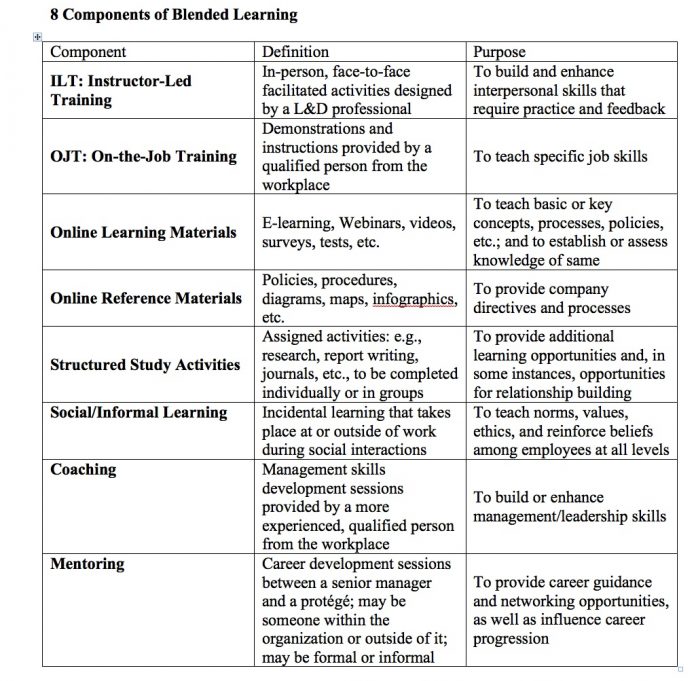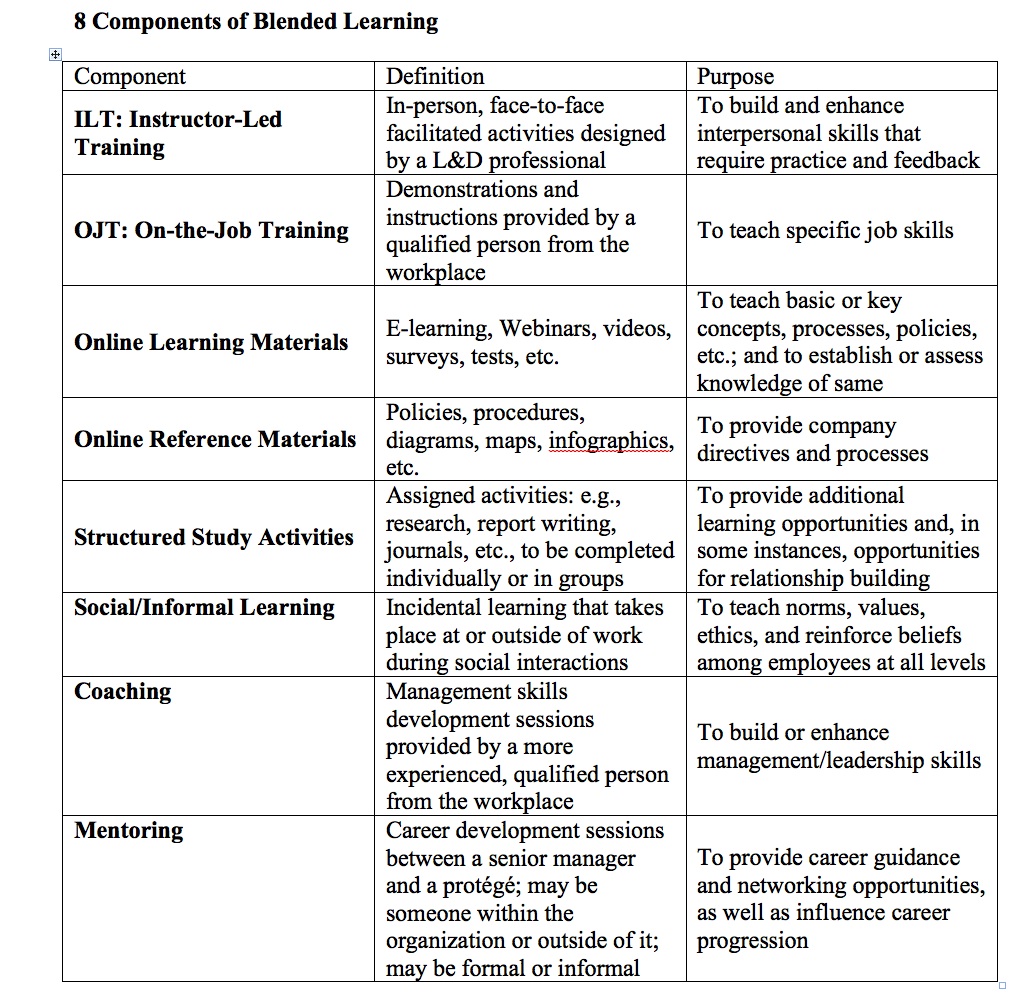
It’s not too difficult to put together learning and development (L&D) programs if you have a large staff and sufficient funding. However, it’s a different story when you are responsible for L&D in a small to medium-sized business where you may be a one-person, do-it-all Training department. That’s especially true when it comes to creating an integrated blended learning program (BLP).
WHAT IS BLENDED LEARNING?
ATD says blended learning consists of: “learning events that combine aspects of online and face-to-face instruction.” That’s a very limited definition. Other sources say there isn’t a single definition of blended learning. A comprehensive blended learning program (BLP) may include as many as eight components. The table below presents each component of a blended learning program and how it is used.

APPLICATION OF BLENDED LEARNING COMPONENTS
It’s likely that an L&D professional in a small to medium-sized company may have access to all eight components of a BLP. That’s not the problem. The problem is time. A one-person or small L&D department is waist deep in an alligator-infested swamp. Everything is important and everything seems to be needed now. The key to making BLPs work is ensuring a proper sequence of learning events/activities.
1. Start with an organizational assessment. The goal is to determine what knowledge, skills, or attitudes are the most essential to the organization’s success. For example, are sales lagging? Is customer support below expectations? Is productivity low? Is morale low? Are employees engaged?
Meet with management to determine what is most important and focus on that. Establish priorities by setting levels of importance. The highest level must be those factors directly affecting finances. It’s understandable that all are important. L&D will earn respect if it can solve problems that influence financial returns.
2. Assess employee competencies. There are two questions to ask to determine competencies: 1) What must the employee know well? 2) What must the employee do well? Make a list of the development needs of each employee in the department with which you are working. Call your list the department’s “DNA” for its employee “development needs assessment.” (It’s easy to add a question about attitudes, but don’t. Focus on knowledge and skills. Changing attitudes is difficult and takes a lot of time. Increasing knowledge and building skills is less time consuming and less difficult.)
3. Start with OJT. Every organization has several, perhaps many, highly skilled, knowledgeable employees. These are the company’s subject matter experts (SMEs). Teach them how to do on-the job training (OJT). Using the department DNAs, assign SMEs appropriately.
Start with those employees who are closest to being fully competent. After they are 100 percent competent, work with the newbies. Don’t waste time with those who are already skilled.
4. Utilize online materials to support the BLP. Notice the verb is “utilize,” not develop. The best place to find free materials is YouTube. In fact, YouTube has a university! Find videos that are relevant and appropriate for the skills that need to be developed. Create a list of titles and links.
5. Assign structured study events. Direct targeted employees to the online materials and have them watch the content. Provide a simple assignment assessment form, which is to be completed and returned. These consist of three to five questions that cover the key points of the online training.
Employees must be paid for watching the videos. Most videos are three to 10 minutes in length. Assume 10 people are in the BLP and they make $15 an hour. Each one is assigned to watch a five minute video. That will cost the company $28.13, assuming you pay them time-and-a-half for overtime. Think about how much time it takes to create and edit a five-minute video. Multiply that times a trainer’s or instructional designer’s hourly salary. Which is the better deal?
The point is, try to use generic resources that are already available for free. Think of these online resources as prerequisites. That allows L&D staff time to create company- or job-specific training that can be used multiple times.
6. Upload company reference materials to a company Intranet. This doesn’t have to be fancy and it doesn’t require a learning management system (LMS). Those are nice, but can be added after the mission-essential BLP is completed. The materials must be current and accurate. Make sure they are available by Web-enabled phones (almost everybody has one). It may cost a couple thousand dollars to have a Web designer create this for you, but that’s not expensive when long-term results are considered.
7. Design and conduct ILT. Utilize the resources of the company’s SMEs as instructors. SMEs know the technicalities of specific jobs. The L&D professional can co-facilitate to ensure learner engagement. Coach the SMEs to help them build their presentation skills as needed.
Rather than spending a significant amount of time trying to create slide decks or e-learning modules, simply make video recordings of the SME demonstrating the skill, process, or technique he or she is teaching. There is no need to add audio. The SME can add narration during the ILT session. Make a video recording of the SME’s presentation and upload that to reinforce what was presented in class. It probably will be necessary to replace the audio track on the video with one that is clearer and easier to understand.
8. Consider coaching, mentoring, and social learning to be “nice-to-haves.” In a one-person shop, program development should be the priority. Expand your OJT to create a coaching program. Don’t worry about mentoring unless the goal of the BLP is to improve leadership skills. Social learning takes care of itself in small companies.
THE BOTTOM LINE
There may be some heretical ideas here. But when you’re up to your butt in alligators, you need to:
1) Get out of the swamp and… 2) Stay out!
By concentrating on the basics, focusing on helping the company compete successfully, and satisfying customers, L&D will prove its worth to those who matter.
Alan Lander’s is CEO of First Step Communications, LLC, and BPO with operations in Islamabad, Pakistan. He is an executive-level organizational development (OD) consultant with more than 35 years of experience. He also serves as president of First Step OD & Training.


